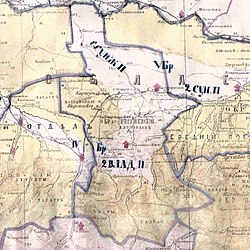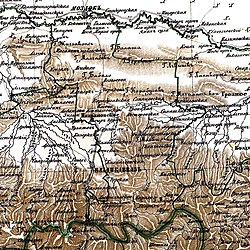Khamkhi
Хамхи | |
|---|---|
| Other transcription(s) | |
| • Ingush | Хамхе |
 | |
| Coordinates: 42°49′20″N 44°55′35″E / 42.82222°N 44.92639°E | |
| Country | Russia |
| Federal subject | Ingushetia |
| Elevation | 1,230 m (4,040 ft) |
| Population | |
| • Total | 0 |
| • Subordinated to | Dzheyrakhsky District |
| Time zone |
UTC+3 (
MSK
|
| Postal code(s) [3] | 386430 |
| OKTMO ID | 26620450161 |
Khamkhi ( Ingush: Хамхе, romanized: Khamkhe) [5] is an ancient city-settlement in Dzheyrakhsky District of Ingushetia. [6] [7] It is part of the rural settlement of Guli (administrative center rural settlement). [8]
On the territory of the city-settlement there is an architectural complex "Khamkhi", represented by many historical objects: megalithic cyclopean tower-type dwellings, 4 combat towers, 4 semi-combat and 16 residential towers, as well as 10 crypt burial grounds. Currently, these objects of Ingush architecture and the entire territory of the settlement are included in the Dzheyrakh-Assa Museum-Reserve and are under state protection.
Geography



Khamkhi is located in Mountainous Ingushetia, on the left bank of the Assa river, on the territory of the historical region "Khyakhale" (from the Ingush "three-town"), being one of its three largest ancient cities-settlements.
History
On the territory of Khamkhi, the remains of megalithic cyclopean dwellings dating back to the 2nd-1st millennium BC were recorded. [9] It is here that scientists localized the ancient ethnonym Khamekits, mentioned by the ancient historian and geographer Strabo (transcribing the words "Khamekits" and "Khamkheti" as the "Country of Khamkhs"). [10] [11] [12]
In the late Middle Ages, Khamkhi was territorially part of the Khamkhin society as its center. The settlement is ancestral home for the following Ingush teips: Khamkhoevs, Izmailovs, Bekbuzarovs, Martazanovs, Katsievs, Adzhievs, Matsievs, Umarovs, Bersanovs, Fatkhilgovs, Kadievs.
In the second half of the 18th century (1770s), the German researcher J.A. Güldenstädt indicated Targim among the total number of Ingush villages and districts. [13] Khamkhi was mentioned as an Ingush village in 1823 by S. M. Bronevskiy. [14]
References
- ^ Russian Federal State Statistics Service (2011). Всероссийская перепись населения 2010 года. Том 1 [2010 All-Russian Population Census, vol. 1]. Всероссийская перепись населения 2010 года [2010 All-Russia Population Census] (in Russian). Federal State Statistics Service.
- ^ "Об исчислении времени". Официальный интернет-портал правовой информации (in Russian). 3 June 2011. Retrieved 19 January 2019.
- ^ Почта России. Информационно-вычислительный центр ОАСУ РПО. (Russian Post). Поиск объектов почтовой связи (Postal Objects Search) (in Russian)
- ^ Итоги Всероссийской переписи населения 2020 года. Федеральная служба государственной статистики.
- ^ Мальсагов 1963, p. 149.
- ^ Чахкиев 2003, pp. 132–133.
- ^ Гадиев, Умалат. "Край башен и легенд — Горная Ингушетия". Archived from the original on 2016-11-08. Retrieved 2023-04-21. // «Discours»
- ^ "Закон Республики Ингушетия от 23 февраля 2009 года № 5-РЗ «Об установлении границ муниципальных образований Республики Ингушетия и наделении их статусом сельского поселения, муниципального района и городского округа»".
- ^ Чахкиев 2003, p. 103.
- ^ Виноградов & Чокаев 1966, p. 67.
- ^ Очерки истории Чечено-Ингушской АССР 1967, p. 25.
- ^ Крупнов 1971, p. 28.
- ^ Гюльденштедт 2002, p. 241.
- ^ Броневский 1823, p. 166.
Bibliography
- Мальсагов, З. К. (1963). Оздоева, Ф. (ed.). Грамматика ингушского языка [Grammar of the Ingush language] (in Ingush and Russian). Vol. 5 (2nd ed.). Грозный: Чечено-Ингушское Книжное Издательство. pp. 1–164.
- Виноградов, В. Б.; Чокаев, К. З. (1966). Виноградов, В. Б. (ed.). Древние свидетельства о названиях и размещении нахских племён [Ancient evidence of the names and location of the Nakh tribes]. Археолого-этнографический сборник (in Russian). Vol. 7 (1st ed.). Грозный: Чечено-Ингушское книжное издательство. pp. 1–179.
- Смирнов, Н. С., ed. (1967). Очерки истории Чечено-Ингушской АССР [Essays on the history of the Checheno-Ingush ASSR] (in Russian). Vol. 1. Грозный: Чечено-Ингушское книжное издательство. pp. 1–316.
- Крупнов, Е. И. (1971). Средневековая Ингушетия [Medieval Ingushetia] (in Russian). Москва: Наука. pp. 1–211.
- Гюльденштедт, Иоганн Антон (2002). "VI. Провинция Кистия, или Кистетия" [VI. Province of Kistia, or Kistetia]. In Карпов, Ю. Ю. (ed.). Путешествие по Кавказу в 1770-1773 гг. [Journey through the Caucasus in 1770-1773.] (in Russian). Translated by Шафроновской, Т. К. Санкт-Петербург: Петербургское Востоковедение. pp. 238–243. ISBN 5-85803-213-3.
- Броневский, С. М. (1823). "Кисты (глава третья)" [Kists (chapter three)]. Новейшие географические и исторические известия о Кавказе (часть вторая) [The latest geographical and historical news about the Caucasus (part two)] (PDF) (in Russian). Москва: Типография С. Селивановского. pp. 151–186.
- Чахкиев, Д. Ю. (2003). Древности Горной Ингушетии [Antiquities of Mountainous Ingushetia] (in Russian). Vol. 1.

